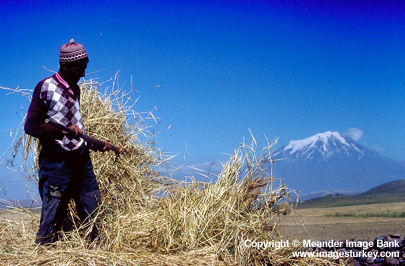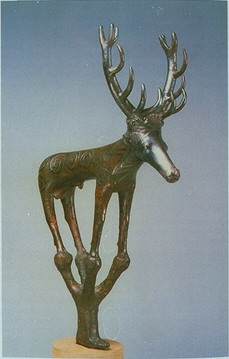THE PALEOLITHIC AGE
Paleolithic Period (Old Stone Age) 600000-10000 BC
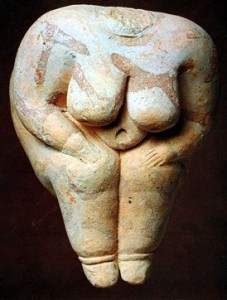
Statuette of a seated nude from Catalhoyuk, one of the earliest examples representing the Mother Goddess. Neolithic period, Museum of Anatolian Civilizations, Ankara
Neanderthal man appeared in the middle Paleolithic age. Homo Sapiens, the ancestor of modern man, were first seen in the upper Paleolithic age.
Life, generally in this age, was perilous and at best uncertain. Survival depended largely on successful hunting, but the hunt often brought sudden and violent death. Social organization rather than bravery shaped subsequent success. Therefore man learned to hunt in groups. In the earlier periods rough stone tools were used but later, tools were refined. Flint hand-axes, scrapers, cutters, and chisels are artifacts which served their specific needs.
Edible plants were gathered. They moved on whenever food resources became scarce. Home for the Paleolithic people also varied according to the environment. In cold regions they sought refuge in caves from the weather, predatory animals and other people.
The most important Paleolithic places in Anatolia are in Yarimburgaz near Istanbul and Karain near Antalya. Karain is the only cave known in Anatolia where all the phases of the Paleolithic age are represented without interruption. It contains a number of habitation levels of this age. Teeth and bone pieces of Neanderthal man and Homo Sapiens have been unearthed in this cave.
THE NEOLITHIC AGE
Neolithic Period (New Stone Age) 8000-5500 BC
The term Neolithic, from the ancient Greek neos “new” and lithos “stone”, was adopted. This age begins with man taking advantage of his environment by cultivating plants and domesticating animals. This is the age in which agriculture started. People did not need to move now as they began to control their conditions. As a result, town life started.
Neolithic farmers usually raised more food than they could consume and their surpluses permitted larger, healthier populations. The surplus of food had two other momentous consequences. First, grain became an article of commerce. The farming community traded surplus grain for items it could not produce itself. The community obtained raw materials such as precious gems and metals. Second, agricultural surplus made the division of labor possible. It freed some members of the community from the necessity of cultivating food. Artisans and craftsmen devoted their attention to making new stone tools for farming, shaping clay into pottery vessels and weaving textiles.
Neolithic farmers domesticated bigger and stronger animals such as the bull and the horse to work for them.
In Anatolia, the earliest evidence of agricultural life was found in Hacilar 25 km / 15 miles SE of Burdur, 7040 BC. Wheat, barley and lentils as well as the bones of goats, sheep and horned cattle were found in the houses of Hacilar. The dog appeared to be the only household animal.
This settlement is best known for its clay female figurines, represented alone or with animals and children.
The most advanced Neolithic center in the Near East is Catalhoyuk, located 50 km / 30 miles SE of Konya and prominent between 6500-5500 BC. Catalhoyuk is a town consisting of rectangular, single-storied houses built of mud-bricks supported by wooden beams and buttresses from the inside. The houses had flat roofs and were built around courtyards. Entrances were through the roofs using ladders. The flat roofs were for defense and provided a working space and passageways from house to house. The houses had the same layout; a living room, a storage room and a kitchen.
Besides animal figures representing fertility, there was also the cult of the mother goddess generally shown with her leopards which was to be repeated many times throughout later Anatolian civilizations.
“Generally speaking, nothing suggests that this precocious culture had its origin exclusively elsewhere than in Turkey and the peoples of the Anatolian plateau may well have played a leading part in the Neolithic Revolution.”
Statuette of a seated nude from Catalhoyuk, one of the earliest examples representing the Mother Goddess. Neolithic period, Museum of Anatolian Civilizations, Ankara
THE CHALCOLITHIC AGE
Chalcolithic Period (Copper Stone Age) 5500-3000 BC
As copper started to be used in addition to stones, this period is called the Chalcolithic age which means Copper Stone Age. Man in this age cultivated crops, herded livestock, lived in brick houses, made vessels of clay, stone, wood or basket work and fashioned weapons of bone or flint. He traded for the raw materials to manufacture his weapons and personal ornaments and his religious beliefs found expression in sculpture and painting. The figure of the Mother Goddess continued, but was domesticated and found in nearly all houses.
Hacilar is the most advanced example of the Chalcolithic culture in Anatolia. The difference of the houses of this age is the number of the floors. They become two storied with an entrance at ground level. The most distinguishing feature of Hacilar is its handmade painted pottery decorated with geometric motifs in reddish brown on a pinkish yellow background.
With the increase of the metal industry, trade developed eastwards with Syria and Mesopotamia and westwards with the Balkans and Mediterranean regions.
Canhasan, 13 km / 8 miles NE of Karaman in the province of Konya, is an important Chalcolithic center together with Beycesultan, Alisar and Alacahoyuk.
THE BRONZE AGE
Bronze Age (3000-1200 BC)
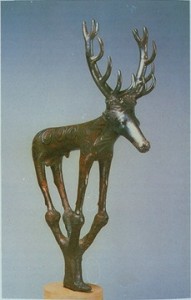
Stag Statuette from Alacahoyuk, Bronze Age, Museum of Anatolian Civilizations, Ankara
The Bronze Age in Anatolia starts with the use of bronze, a mixture of tin and copper. The people of this age made all their weapons, utensils and ornaments from this alloy. In addition to bronze they also used copper, gold, silver and electron; an alloy of gold and silver.
A great advance in metallurgy is notable during this age, especially from the rich finds of gold, silver, bronze and copper excavated. Various vessels, jewelry, bull and stag statuettes, ritual standards, sun-dials (as symbols of the universe) and musical instruments were discovered in the burial chambers of Alacahoyuk. The bull figure plays an important role as a link between the Neolithic and the Hittite religions. Thus, the roots of Hatti and later Hittite religious belief may be inferred as extending as far back as the Neolithic Age in Anatolia.
Men were buried with weapons, women with ornaments and toiletry articles as well as domestic vessels and utensils, many of them in precious metals. The tombs themselves were rectangular pits enclosed by rough stone walls and roofed with timber.
HATTIANS
The Hatti or Hattians were a race of indigenous people who lived in Central Anatolia. As they lived in the prehistoric age before writing was introduced to Anatolia their name has come through Hittite sources. The Hatti gave their name to Anatolia, which was then called the land of the Hatti. Even the Hittites called their own kingdom the land of the Hatti.
The influence of the Hatti civilization is apparent in Hittite religious rites, state and court ceremonies and their mythology. Although they lacked a native written tradition, these people had reached an advanced intellectual level; a richness and sophistication of their own Anatolian culture. They developed true polychrome pottery and also monumental architecture; for example, the 60-room ground level palace at the Kultepe site. The bronze Hatti sun-disc, with its radial lobes representing the planets, shows the complexity of their cosmic views.
ASSYRIAN TRADERS
This period is also known as the Middle Bronze Age during which the old Assyrian state in Mesopotamia established a trading system with Anatolia. In this period Anatolia was divided into feudal city states ruled by indigenous Hattians. They established markets out of cities each of which was called “karum”. There were 20 of these karums ruled by one central market, Kanis, located in Kültepe. They paid tax and rent and in return, security was granted by local rulers. Caravans were employed which generally brought tin, perfumes and ornaments in exchange for goods made of silver and gold.
Written history started in Anatolia with the introduction of the Assyrian language, the cuneiform script and the use of cylinder seals by the Assyrian traders.
The tablets which date back to this period are written in cuneiform script in the language of old Assyria. They are written, baked, put into envelopes and then sealed by re-baking; an example of the first use of envelopes in the world. Most of the tablets are about trading activities with some about private lives of people of this age.
“The figurative symbolism has been one of the most revealing aspects of the finds at Kultepe, because it emphasizes the existence of an authentic and indigenous Anatolian culture persisting through the vicissitudes of migration and political change. A fully developed Anatolian iconography persisted into later centuries, reappearing almost unchanged in the art of the Hittites.”
HITTITES
The Hittites are a people mentioned frequently in the Bible (Old Testament). They were immigrant people who arrived in Anatolia in 2000 BC. It took them 250 years to establish a kingdom in central Anatolia after 1750 BC and their powerful Empire flourished in the 14-13CBC until it was destroyed in 1200 BC by the Sea Peoples.
When the Hittites, who lived north of the Black Sea, migrated into Anatolia that region was already occupied by native people, the Hattians. Their arrival and diffusion had been peaceful and accompanied by intermarriage and alliance with the natives. So well did the Hittites integrate themselves into the local culture of central Anatolia that they even adopted the worship of several native deities.
Hittites named their own state as the land of the Hatti. As Naim Turfan argues, this does not show the tolerance of the conquering Hittites, but their meeting of a much higher level of civilization than their own. For approximately 600 years they continued this habit of borrowing from wherever it suited them.
Another argument by language archeologist, Renfrew claims in 1987 that Indo-European languages derived not from the Russian plains but from Anatolia. The Neolithic people of Anatolia carried their languages together with their plows to Europe and India. In this case the language of the Hittites did not need to come from somewhere, on the contrary, Hittites spoke Anatolian languages. So far Renfrew’s argument has been undisputed.
It is generally accepted that Anitta founded the Hittite State in the 18CBC. Hattusilis I established his capital in the fortress city of Hattusha (Bogazkoy), which remained the principal Hittite administrative center. From a strategic point, Hattusha formed an easily defensible mountain stronghold. Hattusilis I’s campaigns were into northwestern Syria and eastward across the Euphrates River to Mesopotamia. Control of that region was to become a permanent objective of the Hittites in order to increase their economic power.
It remained for Suppiluliumas I (1380-1346 BC), an energetic and successful campaigner, to restore Hittite control in Anatolia and effectively extend the borders of his kingdom to the south and east. His major accomplishments were the defeat of Mitanni and conquests in Syria, including the capture of the powerful city-state of Kargamis. His period saw the Empire at its peak, but even so during that time the Hittite Empire was never a single, political unit. Hittite penetration into Syria brought the newly revived state into conflict with Egypt. A major battle between the Hittites under Muwattalis and the Egyptian King Ramses II was fought at Kadesh on the Orontes River c.1286BC with victory going to the Hittites. They were realistic enough to recognize the limits of their power and far-sighted enough to appreciate the value of peace and an alliance with Egypt. Although there was no real victor in this battle, each side claimed to have won.
The battle was one of the first in history of which a tactical description has survived. The Hittite specialist O. R. Gurney summarizes the Egyptian text as follows:
“The Hittite army based on Kadesh succeeded in completely concealing its position from the Egyptian scouts and as the unsuspecting Egyptians advanced in marching order towards the city and started to pitch their camp, a strong detachment of Hittite chariotry passed round unnoticed behind the city, crossed the river Orontes and fell upon the center of the Egyptian column with shattering force. The Egyptian army would have been annihilated, had not a detached Egyptian regiment arrived most opportunely from another direction and caught the Hittites unawares as they were pillaging the camp. This lucky chance enabled the Egyptian king to save the remainder of his forces and to represent the battle as a great victory.”
The Peace Treaty of Kadesh between Hattusilis III and Ramses II insured peace between the Hittites and Egypt on the southern border of the Empire (1284BC). It is accepted as the first recorded international treaty in the world. The ratification of the treaty was followed by a cordial exchange of letters, not only between the two kings but also from one queen to another. Thirteen years later a daughter of Hattusilis was married to the Egyptian Pharaoh.
In Anatolia, the old pattern of unrest and revolt presented continuing dangers for the Hittite state, as vassals sought to reassert their independence. Beset by both internal and external pressures, the Hittites were unable to resist the onslaught of the Sea Peoples, who overran Anatolia about 1200BC.
Hittite Culture
In addition to the cuneiform script imported from Mesopotamia, the Hittites also used a picture writing form (hieroglyphs) which can be seen on their seals and public monuments. Their rapid adoption of a new cuneiform script made the Hittites the first known literate civilization of Anatolia.
Hittite culture was an amalgamation of native Anatolian and Hurrian elements in religion, literature and art. The scribes of imperial Hattusha were familiar with Sumerian, Assyrian and Babylonian texts and perhaps to some extent with Egyptian materials as well. Hittite culture thus drew to itself a representative sampling of the cosmopolitan perspectives of the ancient Near East. This is reflected in the thousands of cuneiform tablets uncovered in the ruins of the Hittite capital.
The pantheon of Hittite religion included thousands of deities many of them associated with various Anatolian localities. The state cult was dominated by an Anatolian deity called the Sun-goddess Arinna, protectress of the royal dynasty. Her consort was the Weather god Hatti. In the later empire, strong Hurrian influence in Hittite religion appeared with the introduction of the goddess, Hepat, identified with the Sun-goddess and with Teshub, who became identified with the Weather-god. “Zeus’s wife Hera and Adam’s wife Eve are the extensions of Hittite goddess Hepat.”
Hittite literature includes historical annals, royal testaments as well as a number of myths and legends. Many of the latter appear to be of Hurrian origin.
They created the best military architecture of the Near East. Their system of offensive defense works, handed down from the Old Kingdom, grew into a unique type of fortification under the Empire.
The major characteristic of Hittite architecture is its completely asymmetrical ground plan. They employed square piers as supports and had neither columns nor capitals.
Outstanding among examples of Hittite art are the Sphinx Gate of Alacahoyuk and the rock reliefs of Yazilikaya, an outdoor religious shrine in the form of a rock gallery located outside the walls of Hattusha, where two converging lines of male and female deities strikingly depict the major gods of the Hittite Empire.
First seen in a relief of 12 gods in Yazilikaya, the number twelve has been repeated often throughout historic and prehistoric times with 12 Gods of Olympus, 12 Apostles, 12 Imams in Islamic mysticism, 12 in a dozen and 12 months in a year.
Finally, a significant feature of Hittite culture is to be observed in the Hittite Law Code, which appears to be more humane than others in the ancient Near East and in the Hittite practice of treaty relations with allies and vassals during the empire period.
A number of major Anatolian sites have now been excavated that have yielded objects or inscriptions of the Hittite period. Among these, in addition to Hattusha, are Alisar, Alacahoyuk and Kultepe, all in the central Anatolian plateau; Karahoyuk, near Konya in the southwest; and Tarsus and Mersin in the Cilician plain of southern Anatolia.
There is no certain typical tradition with regards to their burial customs, but cremation and inhumation can be seen together. What is interesting is that people were buried with their animals, mostly horses.
Stag Statuette from Alacahoyuk, Bronze Age, Museum of Anatolian Civilizations, Ankara
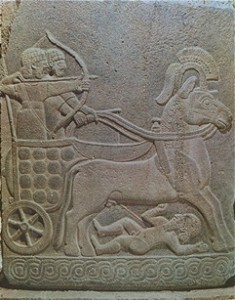
Orthostat Relief From Kargamis Depicting a Chariot Battle, Noe-Hittite period, Museum of Anotolian Civilizations, Ankara
THE IRON AGE
Iron Age (1200-700 BC)
The Iron Age marks the period of the development of technology, when the working of iron came into general use, replacing bronze as the basic material for implements and weapons. It is the last stage of the archaeological sequence known as the three-age system; Stone Age, Bronze Age and Iron Age.
NEO-HITTITES
Following the collapse of Hittite power, Anatolia entered a dark age, not to recover substantially until about 800 BC. The territories previously held by the Hittites in Syria were also pillaged and burned by invaders, but they quickly recovered and reorganized into more than a dozen small independent kingdoms, with a Hittite culture modified by Syrian-Semitic influences. These are known as the Neo-Hittite states. Many of their inhabitants were probably refugees or descendants of refugees from the Hittite homeland. These Neo-Hittites are the Hittites, or “Sons of Heth,” referred to in the Bible. The Neo-Hittite states among them Aleppo, Kargamis, Arpad and Maras were absorbed into the Assyrian Empire by the late 8CBC.
URARTIANS
The Urartians established a state around Lake Van in 1000BC. They were the descendants of the Hurrians who were contemporary to the Hittites in the east and southeast Anatolia. Tushpa near Lake Van, was the capital, with the massive fortress of Van as the citadel.
For about 300 years, from 860-580BC until the invasion of the Medes from the north, Urartu was a formidable regional power. Assyria in Mesopotamia competed with the Assyrian foe for complete hegemony over eastern and south-eastern Anatolia.
PHRYGIANS
The Phrygians were among those migrating peoples known as the “Sea Peoples” who were responsible for the final destruction of the Hittite Empire.
During the period of Midas (8CBC), they rose to be a powerful kingdom and dominated central and southeastern Anatolia. Actually, for the Hellenistic people, this Midas period is the subject of mythology. Midas’s name was perpetuated in epics; for example, the stories of how he became king and how his Gordian knot was cut through and also how his ears were transformed into those of an ass.
IONIANS
From the 11C BC to the 6 BC, three Hellenic tribes of Hellas Ionians, Dors and Aeolians faced with a growing population that could not be fed from the hinterland or the sea, sent out colonies to western Anatolia and some Aegean islands. Out of these three colonies, Ionians became prominent by developing important cities under the influence of the preexisting Anatolian culture.
The term Ionia refers strictly to the central part of the west coast of Anatolia where Ionic Greek was spoken, although the term is usually applied to the entire west coast. Many Mycenaean Greeks emigrated to Ionia in order to escape the invading Dorians (c.1100 BC). Their close contact with the more advanced civilizations of Anatolia; Lydians, Carians, Lycians, Phrygians, even Hittites and Urartians, quickly raised the level of their culture. Trade along with the arts and sciences flourished in Ionia, especially in Miletus.
In 800BC, a league of religious and cultural organization; Panionium was established among 12 principal Ionian cities: Miletus, Myus, Priene, Samos, Ephesus, Colophon, Lebedos, Teos, Erythrae, Chios, Clozomenae and Phocaea.
The Ionians were subjugated by Croesus, ruler of the expanding Kingdom of Lydia, to the north of Ionia. In turn, the Persian King Cyrus the Great conquered Croesus by 546BC, which resulted in the subjugation of the Ionians. They attempted a revolt against Darius I in 499-494, but they were defeated and Miletus was destroyed.
When the Ionian cities fell under the domination of the Persians, all the philosophers and artists migrated to Athens and Italy. Thus, as Professor Ekrem Akurgal argues, the Ionian golden age passed from Anatolia to Athens. In other words, the foundations of the highly admired Greek Civilization were built much before in Anatolia. The first steps of democracy which had been taken in Ionia, were later established in Athens in 508BC.
The Ionians regained their freedom by becoming members of the Delian League.
Alexander the Great’s conquest of the Persian Empire (334-325) freed Ionia, but its cities soon became the prey of contending Hellenistic monarchs. When one of them, Attalus III of Pergamum, died in 133 BC, he bequeathed his kingdom to Rome. Pergamum became the province of Asia and the Ionians became Roman subjects. The Ionian cities continued to be important economic and cultural centers.
Orthostat Relief From Kargamis Depicting a Chariot Battle, Noe-Hittite period, Museum of Anotolian Civilizations, Ankara
THE DARK AGE
Anatolia’s Dark Age (700-490 BC)
After 2,000 years of great civilizations, the eastern world fell into the dark ages in the 8CBC. This was the time that civilizations passed to the western world. At this turning point of world history, the civilized eastern world was represented by the Egyptians, Hittites, Phoenicians, Babylonians, Assyrians and Urartians. The Urartians were the last civilization of this age.
LYDIANS
In ancient times Lydia was the name of a fertile and geologically wealthy region of western Anatolia. It extended from Caria in the south to Mysia in the north and was bound by Phrygia in the east and by the Aegean in the west. Lydia first achieved prominence under the rule of the Mermnad in 680 BC. They underwent some Cimmerian attacks on several occasions. During the reign of Croesus, powerful King of Lydia (560-546 BC), the borders of the state in the east reached as far as Halys (Kizilirmak River). In 546, Croesus was defeated by the Persian King Cyrus and Lydia was dominated by the Persians until Alexander the Great. The country passed to the Romans in 133 AD.
The most important city in Lydia was Sardis (Sart), N of Mount Tmolos (Bozdag), where the Pactolos River (Sartcay) passed through to reach the Hermos River (Gediz). The rich gold deposits of the Pactolos Valley were very important for Lydia’s economy. This wealth was obtained from the alluviums of the mythological Pactolos River.
Lydians claimed to have invented games like knucklebones and dice which they passed on to their Greek neighbors and through them to the rest of the world.
In 640 BC, the first time in history, coins made of electrum (a natural mixture of gold and silver) were used in exchange for goods and facilitated regularization of commercial transactions by the Lydians. This was Lydia’s most significant contribution to human history.
CARIANS
The Carians, from the hinterland of Miletus and Halicarnassus, enter history as mercenaries in the service of the Egyptian king along with their Ionian neighbors in the 7CBC.
In the 5CBC, Caria was ruled by tyrants and princes, some of whom chose the Persian side at the time of the Ionian insurrection. At the end of the 5CBC Caria belonged to the Delian League. It seems to have been constituted as a separate Persian Satrapy. The Carian Satrap Mausolus took part in the great insurrection of the western satraps but later changed sides and conquered Phaselis and western Lycia for the Persian King. Mausolus made Halicarnassus the metropolis of Caria. The architecture of the city included the Satrap’s tomb and the Mausoleum (another of the Seven Wonders of the World). The Mausoleum was planned by Mausolus himself but was actually built by his wife and successor, Artemisia.

